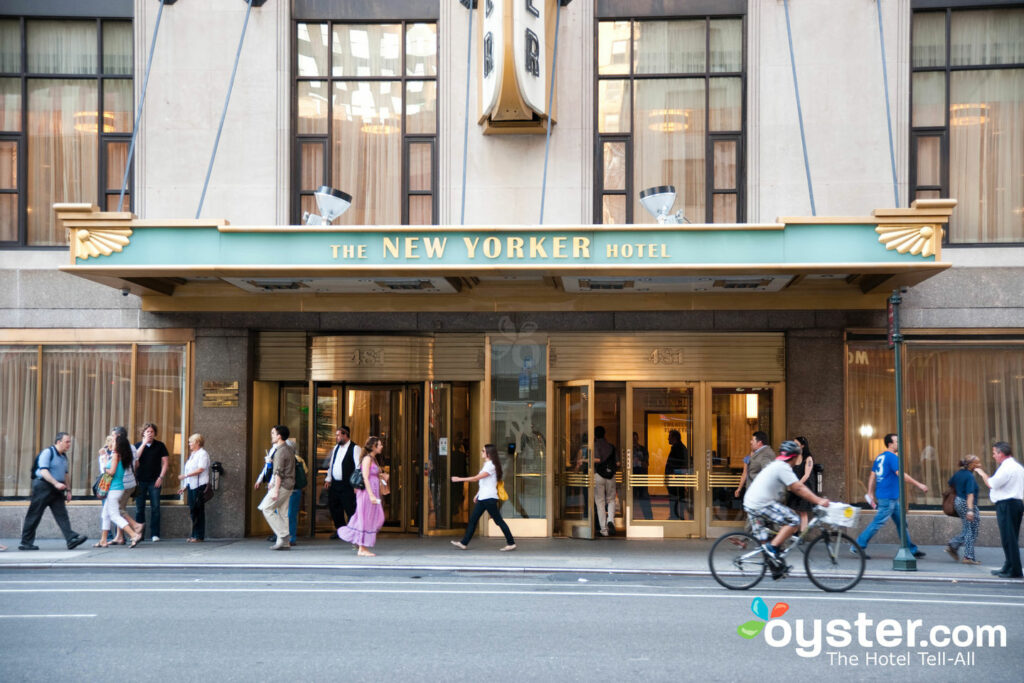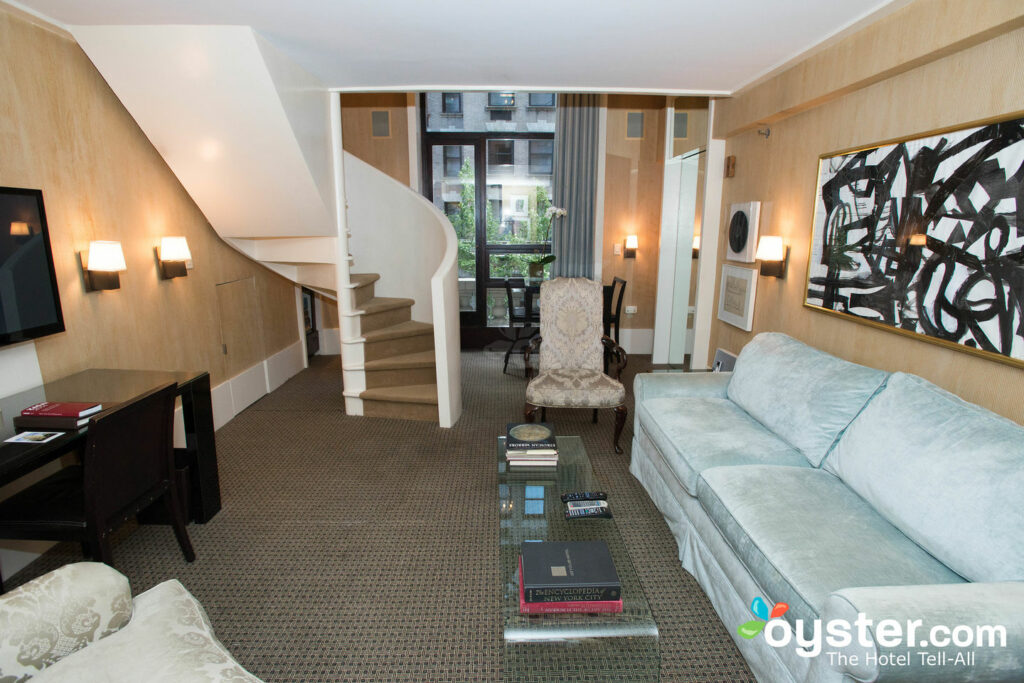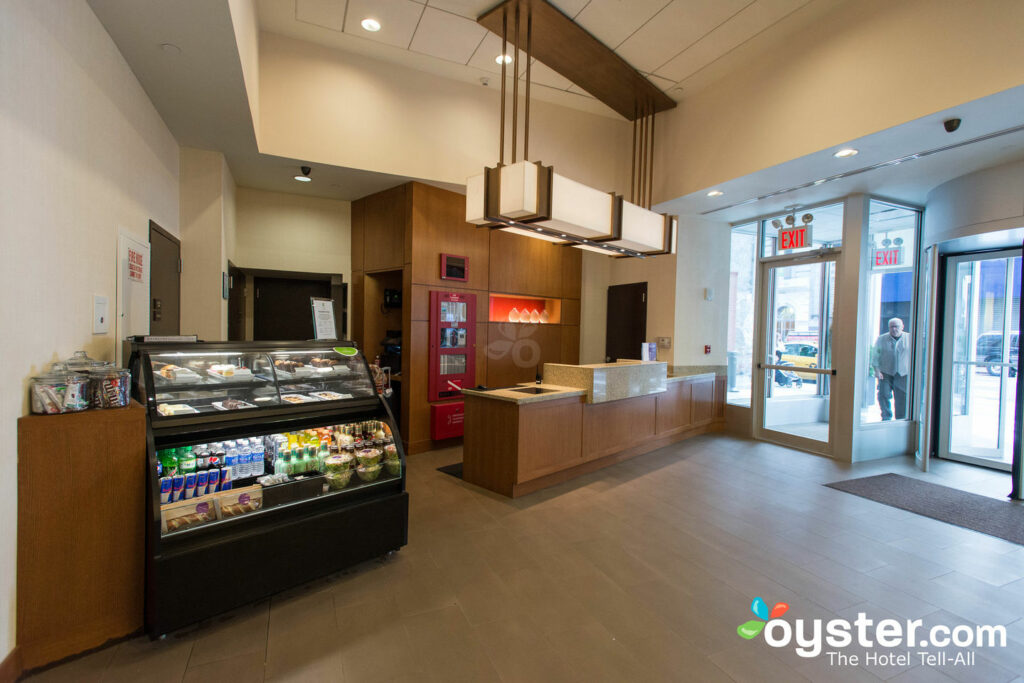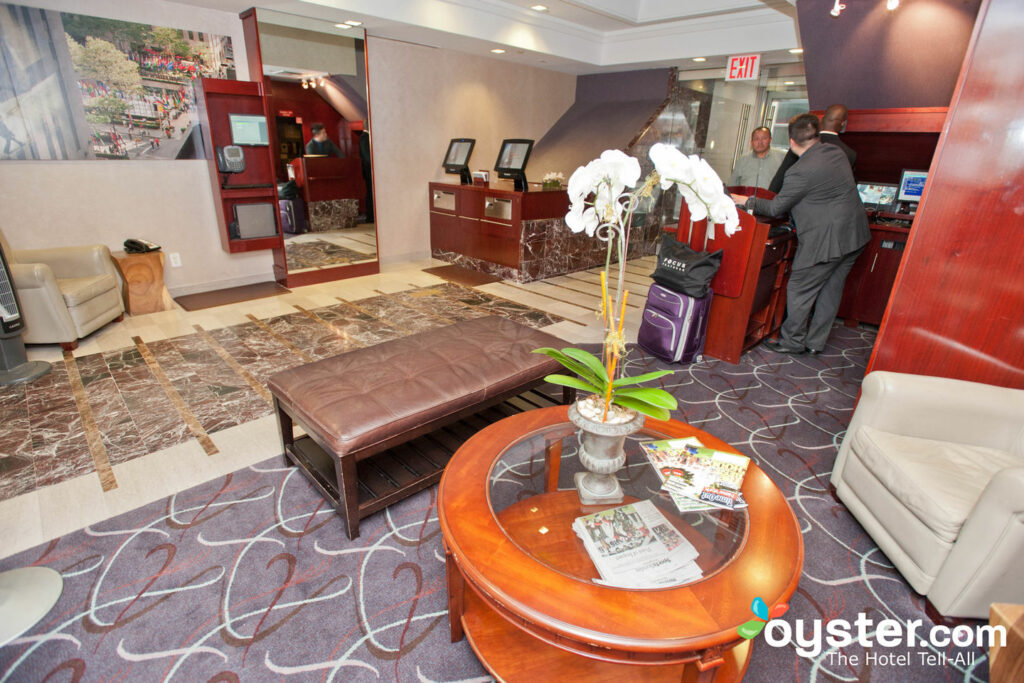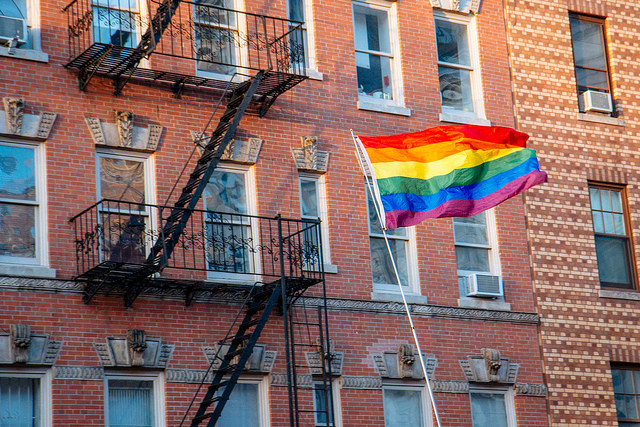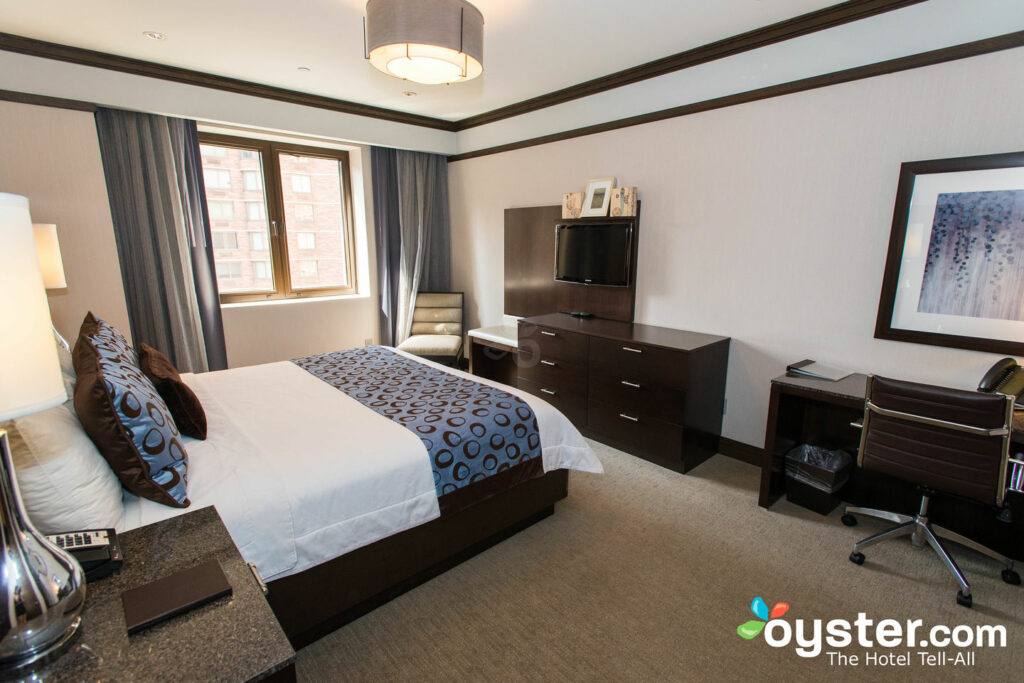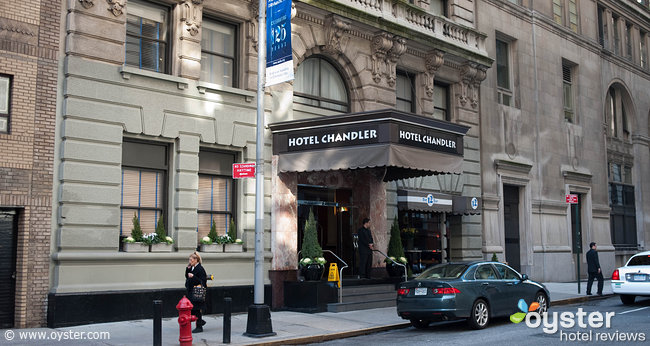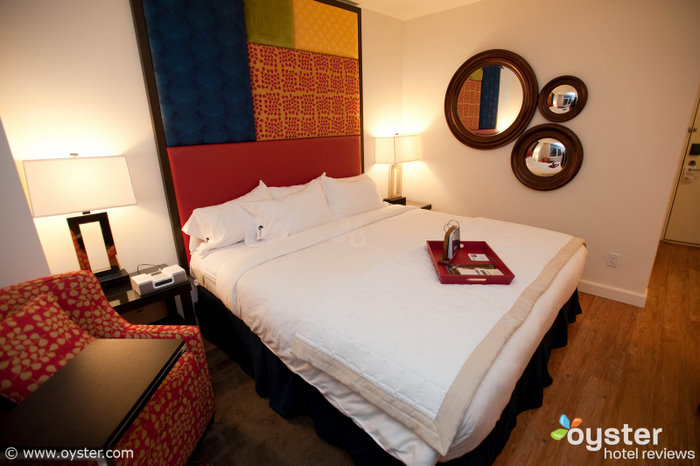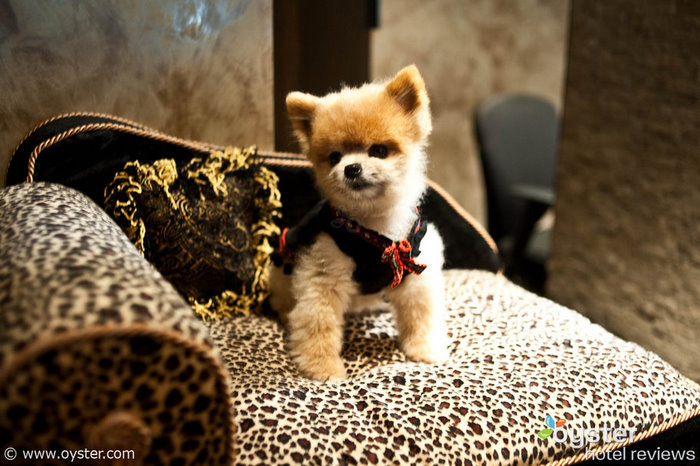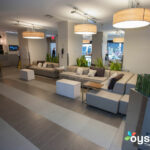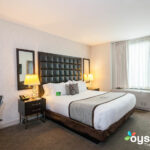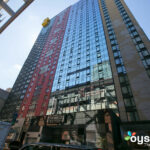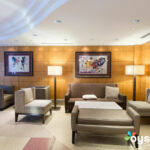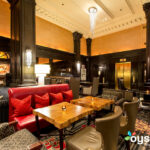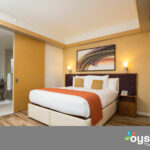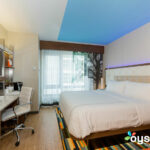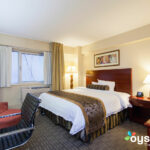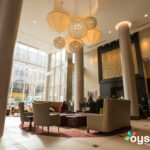Pros
- Clean, bright rooms with neutral tone decor and flat-screen TVs
- Iconic Art Deco building with fascinating history
- Italian restaurant open for lunch and dinner
- Free Wi-Fi
- Adjacent to a Penn Station and subways
- On-site 24-hour diner
Bottom Line
The nice bright rooms, convenient location (next to Penn Station, 10 blocks from Times Square), and rich history make the 912-room Wyndham New Yorker a reasonable pick for the price. A well-equipped gym, two restaurants, and free Wi-Fi add to its value, but note that there's a daily facility fee.
Amenities
- Cribs
- Fitness Center
- Internet
- Pets Allowed
Scene
A large hotel on the south side of Midtown West, the New Yorker attracts a healthy mix of business and leisure travelers -- but its past is more alluring than its present.
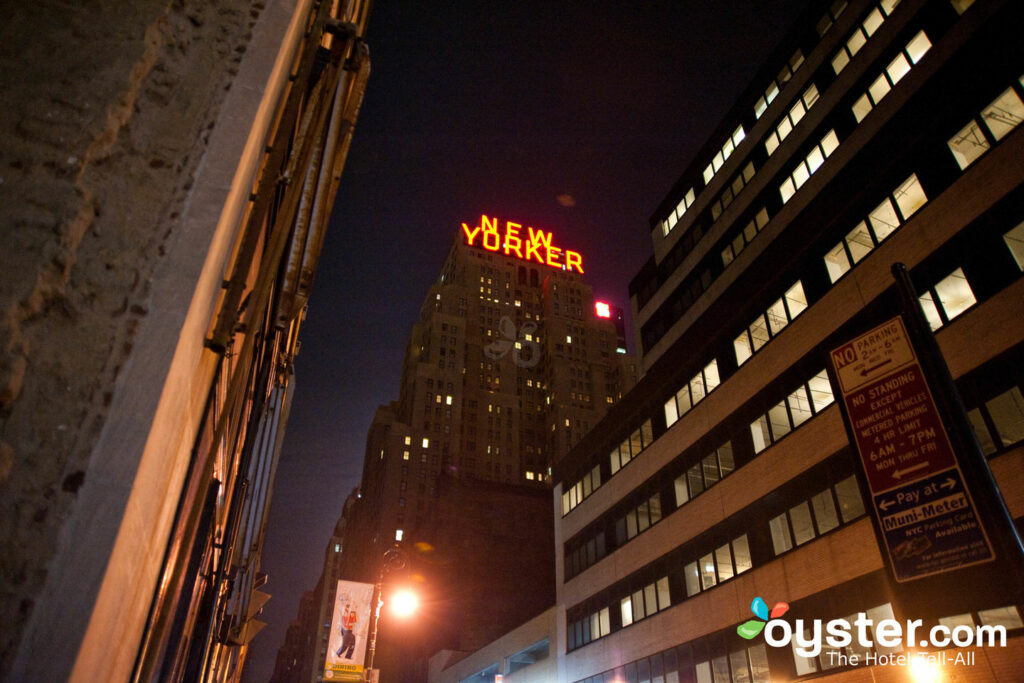
It takes some serious self-confidence to name your hotel the New Yorker. But back in 1930, when the hotel first opened and competition wasn't as fierce, the New Yorker was a city institution hosting silver-screen starlets and foreign dignitaries (more on this in History, below). A lot has happened since then, however, and now it's officially the Wyndham New Yorker Hotel.
Housing 912 rooms on several dozen floors of an iconic Art Deco skyscraper -- its architectural siblings are the Chrysler Building (built in 1930) and the Empire State Building (1931) -- the hotel's New Yorker identity still shines brighter than its corporate connection. (At night it is a literal shine -- the monstrous red New Yorker sign at the top of the building can be seen from all over the westside of Manhattan.) The grand lobby, with its enormous chandelier, evokes its rich old-New-York past. And the hotel certainly embraces its roots: The sign at the entrance and the gold logo on the marble floors show that Wyndham is happy to play a supporting role and let the hotel's venerable past take center stage.
Where does all that leave you? Probably on the fence, if rooms at the nearby Radisson Martinique are only $50 or so more (and if they're equal or less, jump at those instead). The similarly priced Holiday Inn NYC is also a better choice, but that's about 10 blocks away. The only other place in the immediate vicinity, Hotel Pennsylvania, is far inferior to the New Yorker, so if being close to Madison Square Garden is a priority, the New Yorker is a solid bet. If it's not, and you don't mind fighting the crowds in Times Square every time you step outside your hotel's front door, options abound 10 blocks north, like the Best Western President, the Marriott Marquis, and the Hilton Times Square.
Location
Near Madison Square Garden and Penn Station (access to subway and Amtrak), in Midtown West
The New Yorker is on 8th Avenue, between 34th and 35th Streets, which puts it about eight blocks from one of the busiest intersections in the world, at 42nd and Broadway in Times Square. Those blocks make a big difference, though. While the neighborhood is hardly quiet -- it's a block from Penn Station, one of the busiest train stations in the country -- the area is significantly less touristed than its neighbor to the north, especially at night.
The neighborhood itself is a bit of a no-man's land. Some New Yorkers would call it the Garment District; others would simply designate it part of Midwest West. But the distinction isn't really important -- the boundaries of Manhattan's neighborhoods are always a little fuzzy. What's important is that you're within quick walking distance of a number of popular sites, including Times Square, the Empire State Building, and Bryant Park and the New York Public Library. And of course, Madison Square Garden -- home of the New York Knicks, Rangers, and many high-profile concerts -- is only a slapshot away.
- Also nearby: the enormous Manhattan Mall and Macy's East, which claims to be the biggest department store in the world.
- Subway stop for the A, C, E trains right outside its doors, which goes north, to the Upper West Side and Central Park, or south to Chelsea and the Village
- Safety-wise, the area is packed during the day but thins out dramatically late at night, and isn't the best-lit neighborhood. As with almost any area in New York, it isn't wise to wander around poorly lit areas alone late at night, but the neighborhood isn't particularly violent or dangerous.
Airport Transportation
30 to 90 minutes from three airports; plus shuttles and limos to the airport straight from the hotel
New York City has three nearby airports: JFK, LaGuardia, and Newark (in New Jersey). Getting into town from JFK or LaGuardia is usually more convenient than from Newark, but travel times are heavily dependent on the time of day and traffic conditions. From JFK, a taxi to anywhere in Manhattan costs a flat rate of $45 and takes around an hour in average conditions. From LaGuardia, a metered cab ride to Midtown Manhattan costs about $40 and can take 30 minutes if traffic is light, three times that if it's bad. Rides from Newark cost at least $40 plus tolls and can take more than 90 minutes. It's customary to tip your driver 15 to 25 percent.
Those looking to save some cash can use the privately run shuttle buses that are available at all three airports for about $14 per person. Some will actually drop you off right at the New Yorker; they also leave from the hotel every hour. For more information on the shuttles, go to Super Shuttle or New York Airport Service.
Public transit is also available for as little as $7 per person, but travel can take up to two hours and involve a lot of lugging bags up and down stairways.
Rooms
Small, but clean, bright, with flat-screen TVs and free Wi-Fi
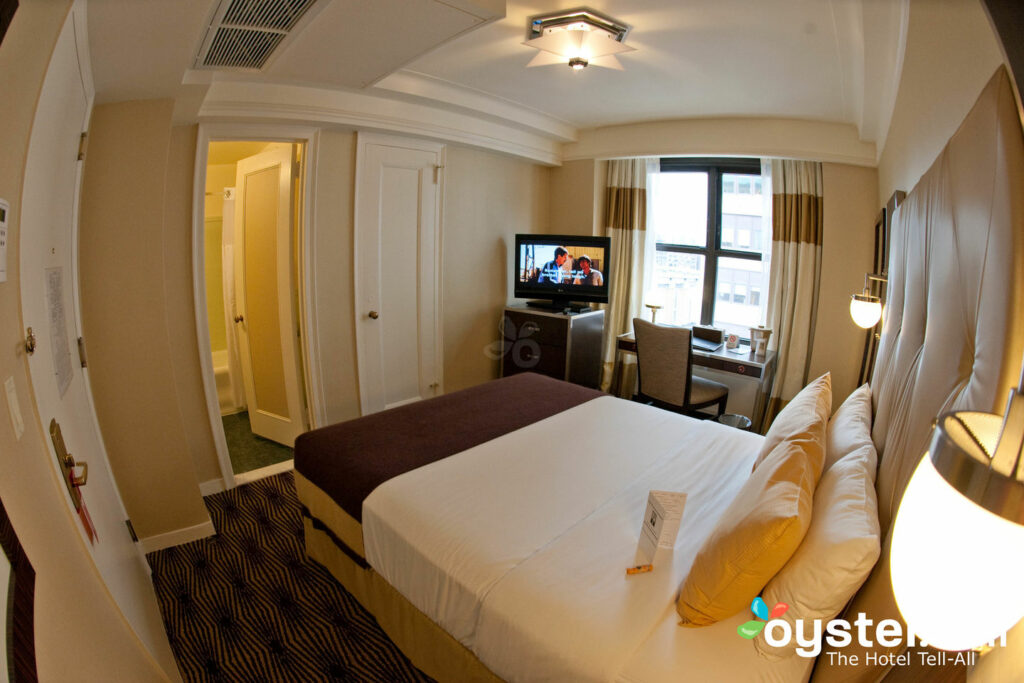


You get the basics at the New Yorker -- a decent bed, plenty of light, a flat-screen TV, and a touch of style -- but no frills or pleasant surprises. According to the New Yorker's website, there are two types of basic rooms -- Metro and City View -- but really, they are identical except for the views. Both types come with queen beds and run small -- 135 to 150 square feet is cozy, even by New York standards. Rooms with two double beds are a bit bigger -- 240 to 260 square feet -- but whether you're sharing a bed or not, you better plan on getting intimate with your roommate. Aesthetically speaking, the rooms were renovated in early 2009, which is a huge plus, but other than gold headboards, they're rather bland. The Executive Rooms were renovated in 2015 and have more personality with silver and blue decor scheme.
- Mediocre beds. The Simmons Beautyrest mattress was too firm for my taste, but at least it wasn't springy. The linens, by the Suite Collection and Convertible Collection, are 60 percent cotton, 40 percent polyester, though that's par for the price.
- Each room comes with a LG flat-screen TV, which shows about 40 channels of basic cable, plus HBO.
- Wi-Fi is free
- Small, but clean, bathrooms; reasonable water pressure in the shower
- iPod docking stations and coffeemakers in higher room categories
Features
A fitness center, business center, and meeting facilities
The New Yorker's fitness center is in a windowless space, but is well-equipped with cardio and strength training machines, as well as free weights. Business travelers will be happy to know there's a business center open 24 hours and spaces available for meetings or events. There's a daily facility fee (around $25 when we were there) that covers usage of the fitness center and the Wi-Fi.
All-Inclusive / Food
An Italian restaurant and a 24-hour diner on-site; myriad options abound nearby
The New Yorker boasts two restaurants, though "boasts" may not be the right word, as both are fine, but not fantastic.
- Trattoria Bianca is an Italian restaurant serving dishes like veal milanese, margherita pizza, and spaghetti carbonara. It's open for lunch and dinner.
- The Tick Tock Diner, on the other side of the lobby, is a retro-50's-era diner open 24 hours.
- Local options abound, though this part of Midwest West is far from the best neighborhood for a foodie. Head south, to the Village, or north to Hell's Kitchen, further north to Columbus Circle, or north still to the Upper West Side for some of the best dining in the world.
- For a more adventurous (and cheap!) dining experience, check out Koreatown, two blocks east, on 32nd Street.
Family
Nothing particularly kid-friendly, but it's a fine place for families
Rollaways (for a nightly fee) and cribs (free) are both available, but the standard (Metro and City View) queen-bed rooms are so small -- 135 to 150 square feet -- they won't fit. You'll have to book a room with two double beds, spring for a suite, or book two adjacent rooms to sleep a family any larger than two people.
- No kids' club or babysitting services
- The area is generally safe, but it does get quiet at night, and could make some parents uncomfortable.
History
A past both illustrious and sordid
When the New Yorker opened in 1930, it was New York's largest hotel, with 2,500 rooms. (Today it has 912 rooms; the title now belongs to the Hilton New York and its 2,000 rooms.) It once employed 92 telephone operators and 150 laundry staff, who washed as many as 350,000 pieces a day. The barbershop alone, one of the largest in the world, boasted 42 chairs and 20 manicurists.
In the 1940s and '50s, the hotel was more than just a hotel. It hosted a number of popular Big Bands and celebrities, including Spencer Tracy and Joan Crawford. Even Fidel Castro stayed here. Its history has also veered into the sordid. The inventor Nikola Tesla spent the last 10 years of his life in near-seclusion in rooms 3327 and 3328 (you can stay there yourself!), where he also died. For more on this, check out this piece in the New Yorker magazine (no relation).
Finally, in 1975, three years after the hotel closed due to poor profits, the controversial Unification Church, led by the Reverend Sun Myung Moon, purchased the building for $5.6 million and converted much of it into church space. Not until 1994 did it reopen as a hotel. Weird, wacky stuff.
This Hotel Also Featured In
2019 Pride Events Around the World: Where to Go and What to Do
West Village, New York; mathiaswasik/Flickr June is just around the corner, marking the start of Pride month in the United States. Cities and communities around the world will gather to commemorate the 50th anniversary of the Stonewall uprising in New York with their own Pride events throughout summer and into fall. Though all Pride festivals…
NYC Hotel Rooms That Sleep Six or More
Manhattan is known for many wonderful things, but huge hotel rooms is not one of them. If you’re traveling with a big brood, you may have resigned yourself to the idea of having to cough up significant cash for multiple rooms, maybe floors apart. And what fun is that? We’re here to tell you it…
Oyster Specials: New York City hotel bargains this Memorial Day weekend (book now, before it’s too late)
There are advantages to traveling to the Big Apple for the Memorial Day weekend. Notably, it’s “Fleet Week,” meaning you’ll find ample stark while sailors strolling the streets (and crowding the bars). The Memorial Day parade struts down Broadway on Monday afternoon (May 31). The best perk: many locals tend to clear out for a…
It's time to book a hotel room for the Big East basketball championship, but where?
Hotel Indigo’s cheery rooms are comfortable and well-equipped, perfect for fans who drag their significant other along.
Pooches on parade: The Westminster dog show comes to New York
Ginger, the teacup Pomeranian that serves as the Muse hotel’s
Things You Should Know About The New Yorker a Wyndham Hotel
Also Known As
- Ramada New York City
- New Yorker Hotel New York
- New Yorker Hotel
- The New Yorker Hotel
- New Yorker Ramada Plaza
- New York City Ramada
- Ramada Hotel New York
- Ramada Plaza New Yorker Hotel
- New Yorker Ramada
- Ramada Plaza New York
- Ramada New Yorker
Room Types
- City View Room
- Metro Room
- New Yorker Room
- New Yorker Suite
- Tower Suite
Address
481 8th Avenue & 34th Street, New York City, New York 10001-1809, United States
Phone
(212) 244-0719
Website
Scene
A large hotel on the south side of Midtown West, the New Yorker attracts a healthy mix of business and leisure travelers -- but its past is more alluring than its present.



It takes some serious self-confidence to name your hotel the New Yorker. But back in 1930, when the hotel first opened and competition wasn't as fierce, the New Yorker was a city institution hosting silver-screen starlets and foreign dignitaries (more on this in History, below). A lot has happened since then, however, and now it's officially the Wyndham New Yorker Hotel.
Housing 912 rooms on several dozen floors of an iconic Art Deco skyscraper -- its architectural siblings are the Chrysler Building (built in 1930) and the Empire State Building (1931) -- the hotel's New Yorker identity still shines brighter than its corporate connection. (At night it is a literal shine -- the monstrous red New Yorker sign at the top of the building can be seen from all over the westside of Manhattan.) The grand lobby, with its enormous chandelier, evokes its rich old-New-York past. And the hotel certainly embraces its roots: The sign at the entrance and the gold logo on the marble floors show that Wyndham is happy to play a supporting role and let the hotel's venerable past take center stage.
Where does all that leave you? Probably on the fence, if rooms at the nearby Radisson Martinique are only $50 or so more (and if they're equal or less, jump at those instead). The similarly priced Holiday Inn NYC is also a better choice, but that's about 10 blocks away. The only other place in the immediate vicinity, Hotel Pennsylvania, is far inferior to the New Yorker, so if being close to Madison Square Garden is a priority, the New Yorker is a solid bet. If it's not, and you don't mind fighting the crowds in Times Square every time you step outside your hotel's front door, options abound 10 blocks north, like the Best Western President, the Marriott Marquis, and the Hilton Times Square.
Location
Near Madison Square Garden and Penn Station (access to subway and Amtrak), in Midtown West
The New Yorker is on 8th Avenue, between 34th and 35th Streets, which puts it about eight blocks from one of the busiest intersections in the world, at 42nd and Broadway in Times Square. Those blocks make a big difference, though. While the neighborhood is hardly quiet -- it's a block from Penn Station, one of the busiest train stations in the country -- the area is significantly less touristed than its neighbor to the north, especially at night.
The neighborhood itself is a bit of a no-man's land. Some New Yorkers would call it the Garment District; others would simply designate it part of Midwest West. But the distinction isn't really important -- the boundaries of Manhattan's neighborhoods are always a little fuzzy. What's important is that you're within quick walking distance of a number of popular sites, including Times Square, the Empire State Building, and Bryant Park and the New York Public Library. And of course, Madison Square Garden -- home of the New York Knicks, Rangers, and many high-profile concerts -- is only a slapshot away.
- Also nearby: the enormous Manhattan Mall and Macy's East, which claims to be the biggest department store in the world.
- Subway stop for the A, C, E trains right outside its doors, which goes north, to the Upper West Side and Central Park, or south to Chelsea and the Village
- Safety-wise, the area is packed during the day but thins out dramatically late at night, and isn't the best-lit neighborhood. As with almost any area in New York, it isn't wise to wander around poorly lit areas alone late at night, but the neighborhood isn't particularly violent or dangerous.
Airport Transportation
30 to 90 minutes from three airports; plus shuttles and limos to the airport straight from the hotel
New York City has three nearby airports: JFK, LaGuardia, and Newark (in New Jersey). Getting into town from JFK or LaGuardia is usually more convenient than from Newark, but travel times are heavily dependent on the time of day and traffic conditions. From JFK, a taxi to anywhere in Manhattan costs a flat rate of $45 and takes around an hour in average conditions. From LaGuardia, a metered cab ride to Midtown Manhattan costs about $40 and can take 30 minutes if traffic is light, three times that if it's bad. Rides from Newark cost at least $40 plus tolls and can take more than 90 minutes. It's customary to tip your driver 15 to 25 percent.
Those looking to save some cash can use the privately run shuttle buses that are available at all three airports for about $14 per person. Some will actually drop you off right at the New Yorker; they also leave from the hotel every hour. For more information on the shuttles, go to Super Shuttle or New York Airport Service.
Public transit is also available for as little as $7 per person, but travel can take up to two hours and involve a lot of lugging bags up and down stairways.
Rooms
Small, but clean, bright, with flat-screen TVs and free Wi-Fi



You get the basics at the New Yorker -- a decent bed, plenty of light, a flat-screen TV, and a touch of style -- but no frills or pleasant surprises. According to the New Yorker's website, there are two types of basic rooms -- Metro and City View -- but really, they are identical except for the views. Both types come with queen beds and run small -- 135 to 150 square feet is cozy, even by New York standards. Rooms with two double beds are a bit bigger -- 240 to 260 square feet -- but whether you're sharing a bed or not, you better plan on getting intimate with your roommate. Aesthetically speaking, the rooms were renovated in early 2009, which is a huge plus, but other than gold headboards, they're rather bland. The Executive Rooms were renovated in 2015 and have more personality with silver and blue decor scheme.
- Mediocre beds. The Simmons Beautyrest mattress was too firm for my taste, but at least it wasn't springy. The linens, by the Suite Collection and Convertible Collection, are 60 percent cotton, 40 percent polyester, though that's par for the price.
- Each room comes with a LG flat-screen TV, which shows about 40 channels of basic cable, plus HBO.
- Wi-Fi is free
- Small, but clean, bathrooms; reasonable water pressure in the shower
- iPod docking stations and coffeemakers in higher room categories
Features
A fitness center, business center, and meeting facilities
The New Yorker's fitness center is in a windowless space, but is well-equipped with cardio and strength training machines, as well as free weights. Business travelers will be happy to know there's a business center open 24 hours and spaces available for meetings or events. There's a daily facility fee (around $25 when we were there) that covers usage of the fitness center and the Wi-Fi.
All-Inclusive / Food
An Italian restaurant and a 24-hour diner on-site; myriad options abound nearby
The New Yorker boasts two restaurants, though "boasts" may not be the right word, as both are fine, but not fantastic.
- Trattoria Bianca is an Italian restaurant serving dishes like veal milanese, margherita pizza, and spaghetti carbonara. It's open for lunch and dinner.
- The Tick Tock Diner, on the other side of the lobby, is a retro-50's-era diner open 24 hours.
- Local options abound, though this part of Midwest West is far from the best neighborhood for a foodie. Head south, to the Village, or north to Hell's Kitchen, further north to Columbus Circle, or north still to the Upper West Side for some of the best dining in the world.
- For a more adventurous (and cheap!) dining experience, check out Koreatown, two blocks east, on 32nd Street.
Family
Nothing particularly kid-friendly, but it's a fine place for families
Rollaways (for a nightly fee) and cribs (free) are both available, but the standard (Metro and City View) queen-bed rooms are so small -- 135 to 150 square feet -- they won't fit. You'll have to book a room with two double beds, spring for a suite, or book two adjacent rooms to sleep a family any larger than two people.
- No kids' club or babysitting services
- The area is generally safe, but it does get quiet at night, and could make some parents uncomfortable.
History
A past both illustrious and sordid
When the New Yorker opened in 1930, it was New York's largest hotel, with 2,500 rooms. (Today it has 912 rooms; the title now belongs to the Hilton New York and its 2,000 rooms.) It once employed 92 telephone operators and 150 laundry staff, who washed as many as 350,000 pieces a day. The barbershop alone, one of the largest in the world, boasted 42 chairs and 20 manicurists.
In the 1940s and '50s, the hotel was more than just a hotel. It hosted a number of popular Big Bands and celebrities, including Spencer Tracy and Joan Crawford. Even Fidel Castro stayed here. Its history has also veered into the sordid. The inventor Nikola Tesla spent the last 10 years of his life in near-seclusion in rooms 3327 and 3328 (you can stay there yourself!), where he also died. For more on this, check out this piece in the New Yorker magazine (no relation).
Finally, in 1975, three years after the hotel closed due to poor profits, the controversial Unification Church, led by the Reverend Sun Myung Moon, purchased the building for $5.6 million and converted much of it into church space. Not until 1994 did it reopen as a hotel. Weird, wacky stuff.
Best Rates
Amenities
-
Air Conditioner
-
Airport Transportation
-
Balcony / Terrace / Patio
-
Business Center
-
Cable
-
Concierge
-
Cribs
-
Dry Cleaning
-
Fitness Center
-
Internet
-
Kids Allowed
-
Laundry
-
Meeting / Conference Rooms
-
Pets Allowed
-
Rental Car Service Desk Onsite
-
Room Service
-
Separate Bedroom / Living Room Space
Disclaimer: This content was accurate at the time the hotel was reviewed. Please check our partner sites when booking to verify that details are still correct.
